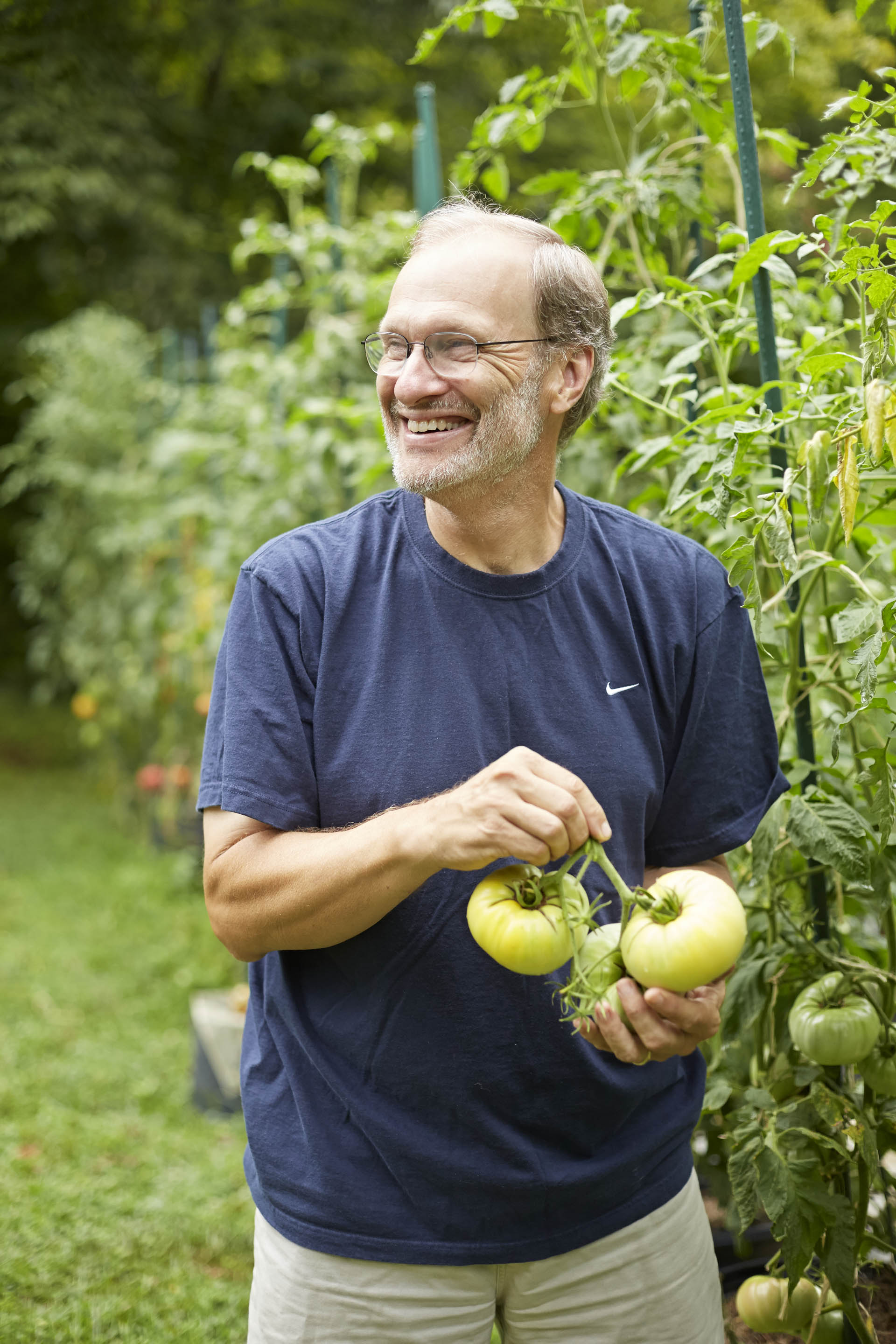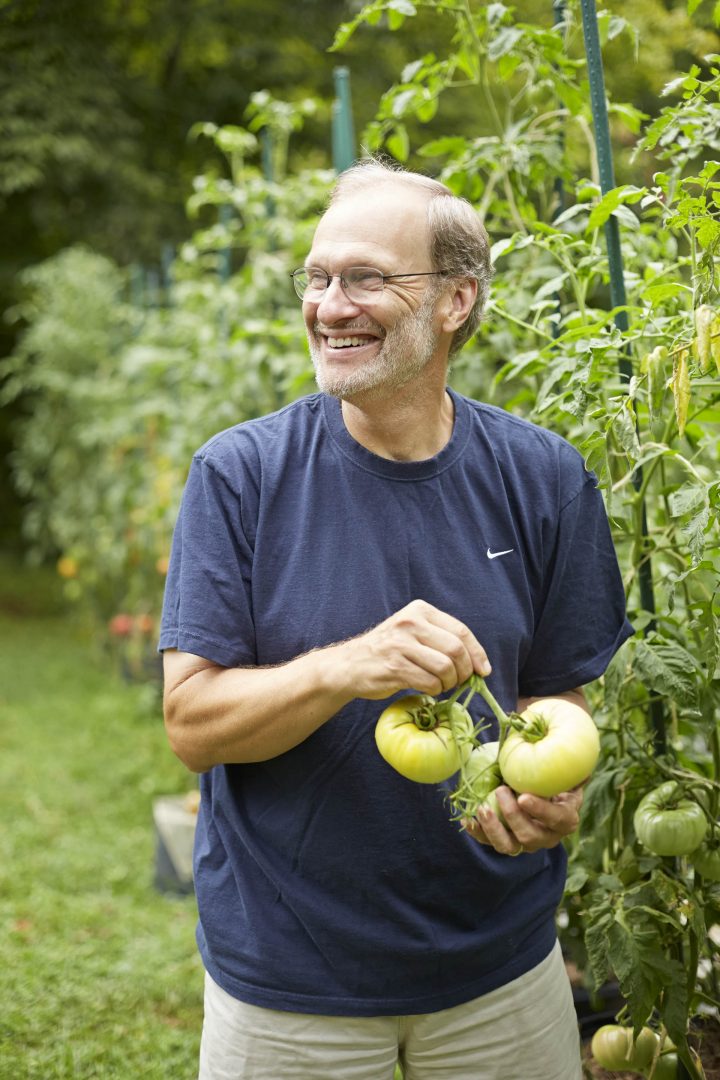By Dr. Craig LeHoullier, the “NC Tomatoman” (the fellow who named Cherokee Purple in 1990) and speaker at the 2016 Sustainable Agriculture Conference, Nov. 4 – 6 in Durham.
Summer eating conjures up so many feelings, thoughts, and cravings. Walks through a mid-summer farmers market brings us face to face with piles of peppers, stacks of summer squash, glossy, colorful eggplant, and succulent melons of all sorts. Then there are the peaches, blue- and blackberries, sweet corn, and green and yellow snap beans competing for our attention.
And yet – as awesome and appetite stimulating and recipe searching as all of the above represents, for many, it is the large, often misshapen, rather humble looking tomato that draws us, sends us hunting stall to stall…then, later on, slicing and serving and making them the centerpiece of our warm weather meals.
For those who dig in the dirt to grow their own bounties, tomatoes are typically the centerpiece of the garden.
With literally thousands of varieties available to those who start their own seedlings, it is possible to grow completely different menus of tomatoes each summer for one’s entire life and never experience a repetition.
CFSA is on a mission to bring local, organic food to your table from a farmer you can trust. Join CFSA’s Perennial Givers Guild and your monthly donation of any amount will help us grow local & organic from seed to plate.
Why do we love them so?
I’ve thought a good bit about the attraction of this fleeting, perishable object – one that for many is best enjoyed seasonally, just like asparagus, strawberries and sugar snap peas. Perhaps it is just that – the ethereal nature of a “real” tomato creates deep longing during those months of unavailability. I believe that another important aspect is nostalgia. Along with locally grown sweet corn, tomatoes were often the target for those Sunday drives with parents, or grandparents, aimed at a nearby farm stand, carefully selected, and used as the centerpiece of a backyard picnic.

Tomatoes have other admirable qualities for those who wish to explore beyond the culinary aspect. They are one of the easier crops for those who enjoy saving and sharing seeds. Many come with wonderful handed down stories, having truly passed the test of time; this is often reflected in their names (Lillian’s Yellow Heirloom, Mortgage Lifter, Aunt Ruby’s German Green – all of which sound a whole lot more enticing than “Big Boy,” at least to me).
Not really hard to grow….yet they need love to thrive
Anyone who has a few hours of sun should grow their own tomatoes. Thousands of varieties means not only choice, but flexibility – which allows the gardener to fit the tomato to the space and sun. The larger the tomato, the more sun it needs. The taller growing the variety, the more soil it needs.
It is easier and easier to find a wide range of seedlings at local garden center for those who wish to start with plants. Those who want to start their own plants from seed should work back two months from the last frost date to determine when to begin.
The tomato enthusiast has every choice imaginable for a planting location. Along with typical dirt gardens (in which good drainage is the key success factor), raised beds, containers and straw bales are all options that can be equally successful. The quality of the planting medium in the beds or containers is an important consideration. It is also important to water and feed the plants more often.

I like to say that tomatoes are similar to roses in that every weather irregularity, critter and disease can play havoc with your venture. Cool weather means slower growth, but high heat and humidity can make the blossoms drop off, leading to reduced yields. Tomato diseases come in three flavors – bacterial, viral and fungal, with many examples in each category. Some are in the soil, some on the soil, some spread by insects. Deer, squirrels, birds, and various worms and beetles could be quite enticed by your efforts.
Yet it is worth it. Good planning, good garden hygiene, and regular trouble shooting and monitoring of the plants help foster success. Every year is different – and it can be hard to find the rhyme or reason why. I’ve grown tomatoes in Raleigh, NC, for 25 years, and I’ve had spectacular successes followed by grim disappointments. I expect to keep doing this for another 25 years, if I can – because it is indeed worth it.
Colors, shapes, sizes, flavors, stories – choices!
We are really lucky that the Seed Savers Exchange (SSE) came into being in 1975. We would not have the staggering number of options available if it were not for the preservation and sharing efforts that the SSE began, and continues to this day.
When considering tomato diversity, there are simply so many aspects to choose from. Sizes range from pea-sized (Mexico Midget) to 2 plus pound monsters (Mortgage Lifter). The shapes can be flattened (Yellow Brandywine) to round (Eva Purple Ball) to a carbon copy of a big frying pepper (Speckled Roman). Colors range from red and pink of Aker’s West Virginia and German Johnson (one of the few true North Carolina heirlooms), respectively, to hues ranging from nearly white (Dwarf Mr. Snow) to yellow (Hugh’s) to pumpkin orange (Kellogg’s Breakfast). There are the stripes of Pink Berkeley Tie Dye and the swirls of Ruby Gold. Some of the best flavored of all have remarkably dark color (Cherokee Purple and Cherokee Chocolate), or don’t even budge when ripening, staying as green as can be (Green Giant).

After growing more than 2,000 types, I can honestly say that flavor and color don’t necessarily correlate. There are sweet, tart, intense, bland, mild, complex and simple examples for each color. It’s all in the genes – the size, color, and shape – and my preference is to take each variety of tomato on its own merit – whether I am for it, or choose to avoid it.
Finally, for those who are space-challenged and hope to grow great tasting, interestingly colored tomatoes on their deck or patio or (like me!) driveway, a selection of dwarf growing tomatoes created by a unique collaborative project co-led by me since 2005 just could be the answer. Fill a 5 gallon pot with good quality planting medium, find yourself a Dwarf Sweet Sue or Dwarf Wild Fred or Rosella Crimson (just 3 of our 60 new varieties), support the plant with a 4 foot stake or cage….and be amazed at what you will achieve.
Craig LeHoullier gardens with his wife in Raleigh, NC, surrounded by his assorted dogs and cats. A chemist by education, he retired from a 25 year career in Pharma to write books. Epic Tomatoes emerged in 2014, and Growing Vegetables in Straw Bales in 2015 (Storey Publishing). Information on the Dwarf Tomato Breeding Project and his various speaking engagements, as well as his regular gardening blog, can be found at www.craiglehoullier.com.


